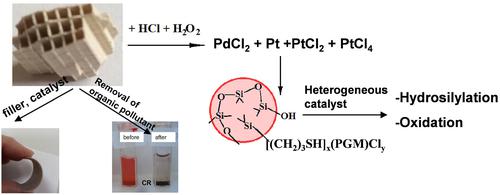当前位置:
X-MOL 学术
›
Appl. Organomet. Chem.
›
论文详情
Our official English website, www.x-mol.net, welcomes your
feedback! (Note: you will need to create a separate account there.)
New heterogeneous catalysts containing platinum group metals recovered from a spent catalytic converter
Applied Organometallic Chemistry ( IF 3.7 ) Pub Date : 2021-08-25 , DOI: 10.1002/aoc.6417 Carmen Racles 1 , Mirela‐Fernanda Zaltariov 1 , Adina Coroaba 2 , Mihaela Silion 3 , Cornelia Diac 4 , Andrei Dascalu 2 , Mihail Iacob 1 , Maria Cazacu 1
Applied Organometallic Chemistry ( IF 3.7 ) Pub Date : 2021-08-25 , DOI: 10.1002/aoc.6417 Carmen Racles 1 , Mirela‐Fernanda Zaltariov 1 , Adina Coroaba 2 , Mihaela Silion 3 , Cornelia Diac 4 , Andrei Dascalu 2 , Mihail Iacob 1 , Maria Cazacu 1
Affiliation

|
A spent catalytic converter was treated with concentrated HCl and hydrogen peroxide in very mild conditions to extract approximately half of its platinum group metals (PGMs) content, mainly as chlorides. The noble metals were subsequently charged into functionalized mesoporous silica by complexation with mercapto groups. A combination of methods was employed to prove the transfer of PGMs and to characterize the materials (inductively coupled plasma optical emission spectrometry [ICP-OES], Fourier transform-infrared [FT-IR] spectroscopy, electrospray ionization mass spectrometry [ESI-MS], thermogravimetric analysis [TGA], X-ray photoelectron spectroscopy [XPS], X-ray diffraction, and UV–Vis spectrophotometry). The resulted PGM-loaded silica was successfully tested as a new heterogeneous catalyst for hydrosilylation and oxidation reactions. Information about the nature of the PGMs species extracted and loaded completes the existing literature data. The scrap cordierite may be valorized for retention of pollutants from water and also catalyzes the hydrosilylation reaction based on the remaining PGMs. Flexible composite materials can be obtained by incorporating scrap cordierite as filler and crosslinking catalyst into a silicone matrix, significantly enhancing the dielectric permittivity. Thus, complete re-valorization of the main components of the catalytic converter as high-added-value materials was achieved at laboratory level, with very low energy demanding procedures.
中文翻译:

从废催化转化器中回收的含有铂族金属的新型多相催化剂
在非常温和的条件下用浓 HCl 和过氧化氢处理废催化转化器,以提取其铂族金属 (PGM) 含量的大约一半,主要是氯化物。随后通过与巯基络合将贵金属装入官能化的介孔二氧化硅中。采用多种方法来证明 PGM 的转移和表征材料(电感耦合等离子体发射光谱 [ICP-OES]、傅里叶变换红外 [FT-IR] 光谱、电喷雾电离质谱 [ESI-MS] 、热重分析 [TGA]、X 射线光电子能谱 [XPS]、X 射线衍射和紫外-可见分光光度法)。所得负载 PGM 的二氧化硅作为一种用于氢化硅烷化和氧化反应的新型多相催化剂被成功测试。有关提取和加载的 PGM 物种性质的信息完善了现有的文献数据。废堇青石可用于保留水中的污染物,并且还基于剩余的 PGM 催化氢化硅烷化反应。通过将废堇青石作为填料和交联催化剂加入有机硅基质中,可以得到柔性复合材料,显着提高介电常数。因此,在实验室水平上实现了催化转化器主要部件作为高附加值材料的完全再价值化,且能耗要求非常低。废堇青石可用于保留水中的污染物,并且还基于剩余的 PGM 催化氢化硅烷化反应。通过将废堇青石作为填料和交联催化剂加入有机硅基质中,可以得到柔性复合材料,显着提高介电常数。因此,在实验室水平上实现了催化转化器主要部件作为高附加值材料的完全再价值化,且能耗要求非常低。废堇青石可用于保留水中的污染物,并且还基于剩余的 PGM 催化氢化硅烷化反应。通过将废堇青石作为填料和交联催化剂加入有机硅基质中,可以得到柔性复合材料,显着提高介电常数。因此,在实验室水平上实现了催化转化器主要部件作为高附加值材料的完全再价值化,且能耗要求非常低。
更新日期:2021-08-25
中文翻译:

从废催化转化器中回收的含有铂族金属的新型多相催化剂
在非常温和的条件下用浓 HCl 和过氧化氢处理废催化转化器,以提取其铂族金属 (PGM) 含量的大约一半,主要是氯化物。随后通过与巯基络合将贵金属装入官能化的介孔二氧化硅中。采用多种方法来证明 PGM 的转移和表征材料(电感耦合等离子体发射光谱 [ICP-OES]、傅里叶变换红外 [FT-IR] 光谱、电喷雾电离质谱 [ESI-MS] 、热重分析 [TGA]、X 射线光电子能谱 [XPS]、X 射线衍射和紫外-可见分光光度法)。所得负载 PGM 的二氧化硅作为一种用于氢化硅烷化和氧化反应的新型多相催化剂被成功测试。有关提取和加载的 PGM 物种性质的信息完善了现有的文献数据。废堇青石可用于保留水中的污染物,并且还基于剩余的 PGM 催化氢化硅烷化反应。通过将废堇青石作为填料和交联催化剂加入有机硅基质中,可以得到柔性复合材料,显着提高介电常数。因此,在实验室水平上实现了催化转化器主要部件作为高附加值材料的完全再价值化,且能耗要求非常低。废堇青石可用于保留水中的污染物,并且还基于剩余的 PGM 催化氢化硅烷化反应。通过将废堇青石作为填料和交联催化剂加入有机硅基质中,可以得到柔性复合材料,显着提高介电常数。因此,在实验室水平上实现了催化转化器主要部件作为高附加值材料的完全再价值化,且能耗要求非常低。废堇青石可用于保留水中的污染物,并且还基于剩余的 PGM 催化氢化硅烷化反应。通过将废堇青石作为填料和交联催化剂加入有机硅基质中,可以得到柔性复合材料,显着提高介电常数。因此,在实验室水平上实现了催化转化器主要部件作为高附加值材料的完全再价值化,且能耗要求非常低。











































 京公网安备 11010802027423号
京公网安备 11010802027423号